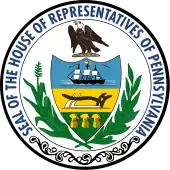George Latimer (Pennsylvania politician)
George Latimer (July 8, 1750 – June 12, 1825)[1] was a Philadelphia merchant[2] and member of the Pennsylvania House of Representatives. He served as speaker of the Pennsylvania House 1794–1798.
George Latimer | |
|---|---|
| 3rd Speaker of the Pennsylvania House of Representatives | |
| In office 1794–1798 | |
| Preceded by | Gerardus Wynkoop |
| Succeeded by | Cadwalader Evans |
| Personal details | |
| Born | 1750 Newport, Delaware |
| Died | 1825 |
| Political party | Federalist |
| Profession | Merchant |
Early life
Latimer was born in Newport, Delaware.[1]
Personal life
Latimer married Margaret Cathcart on February 20, 1771. They had two daughters and one son.[1]
He was severely injured after being thrown from his horse. He could not walk a great distance and had to be driven to his place of business.[1]
By 1892, he had no living direct descendants.[1]
Military service
Latimer was a lieutenant-colonel in the Revolutionary Army.[1]
Political activities
In 1779, Latimer was elected as an assemblyman from New Castle County, Delaware.[3]
He served in the Pennsylvania House of Representatives from 1792 to 1799.[4] He ran for a House seat in 1789.[5]
In 1791, Latimer (along with Henry Drinker, Robert Hare, Joseph Heister, George Fry, William Montgomery, and Samuel Miles) was named in a bill as a commissioner of a company to open a canal and lock navigation system between the Schuylkill and Susquehanna Rivers, the Schuylkill and Susquehanna Navigation Company. The bill passed the House and was scheduled to be read for a third time in the state Senate.[6]
He was named as a presidential elector for the Election of 1792.[7]
Latimer served as Speaker of the Pennsylvania House of Representatives from 1794–1798. Election dates:
- 1794: December 3, 1793[8]
- 1795: December 4, 1794[9]
- 1796: December 2, 1795 (34 votes....William Maclay had 13 votes)[10]
- 1797: December 7, 1796[11]
- 1798:[12] unknown
Latimer was chairman of a meeting in Philadelphia for the support of State Senate candidate Benjamin R. Morgan.[13]
He was a collector of customs at Philadelphia,[14] 1798[15] – May 11, 1802 (replaced by General Peter Muhlenberg).[16] The Poulson's American Daily Advertiser claimed that he was forced to resign and hoped the details would be made public. They also suggested that General Muhlenberg was put in this position so as to prevent a future gubernatorial candidacy.[17]
In 1802, Latimer was nominated for a seat in the United States House of Representatives by the Federalist Party.[18] He came in fourth out of six candidates, receiving 1,599 votes.[19]
He served as a Federalist presidential elector in the Election of 1804.[20]
Business Activities
Latimer was elected as a director of the Bank of the United States in October, 1791.[21]
Latimer served as president of the Union Fire Insurance Company.[1] His merchant businesses were located at 71 South Wharves and 1 Pine Street.[1]
Other activities
Latimer became a member of the Hibernian Society in 1790.[1]
Sources
- Campbell, John Hugh (1892), History of the Friendly Sons of St. Patrick and of the Hibernian Society for the Relief of Emigrants from Ireland: March 17, 1771 – March 17, 1892, Hibernian Society, pp. 119–120
- "(Advertisement)", Independent Gazetteer, p. 3, April 24, 1784
- "(Legislative)", Pennsylvania Packet, p. 3, October 19, 1779
- Hamilton, Alexander; Syrett, Harold C. (1975), The Papers of Alexander Hamilton: July 1798 to March 1799, Columbia University Press, p. 133, ISBN 0-231-08921-X
- Independent Gazetteer (Philadelphia), p. 2, October 12, 1789 Missing or empty
|title=(help) - Dunlap's American Daily Advertiser, p. 2, September 27, 1791 Missing or empty
|title=(help) - "For Electors of a President and Vice President of the United States", Dunlap's American Daily Advertiser, p. 2, October 3, 1792
- Federal Gazette, p. 3, December 4, 1793 Missing or empty
|title=(help) - "Legislature of Pennsylvania", Gazette of the United States, p. 3, December 5, 1794
- "Philadelphia, Thursday Evening, December 3, 1795", Gazette of the United States, p. 3, December 3, 1795
- Philadelphia Gazette, p. 3, December 8, 1796 Missing or empty
|title=(help) - Farmers' Register, p. Supplement (21), May 16, 1798 Missing or empty
|title=(help) - Gazette of the United States, p. 3, February 20, 1798 Missing or empty
|title=(help) - Marcus, Maeva; Perry, James R. (2007), The documentary history of the Supreme Court of the United States, 1789–1800 (8 ed.), Columbia University Press, p. 397, ISBN 978-0-231-13976-2
- "(Advertisement)", Porcupine's Gazette, p. 2, October 29, 1798
- Carlisle Gazette, p. 3, May 12, 1802 Missing or empty
|title=(help) - Poulson's American Daily Advertiser, p. 3, July 29, 1802 Missing or empty
|title=(help) - "Federal Republican Meeting", Philadelphia Gazette, p. 1, September 11, 1802
- Gazette of the United States, p. 2, October 14, 1802 Missing or empty
|title=(help) - Pennsylvania Correspondent, p. 3, October 30, 1804 Missing or empty
|title=(help) - Federal Gazette, p. 3, October 17, 1791 Missing or empty
|title=(help)
- "Latimer, George, 1750-1825". Tufts University. Retrieved February 6, 2018.
